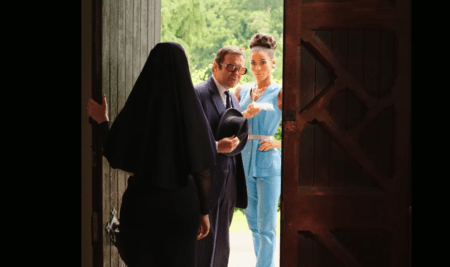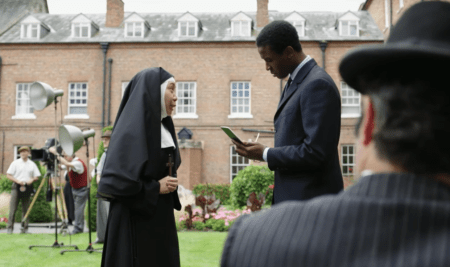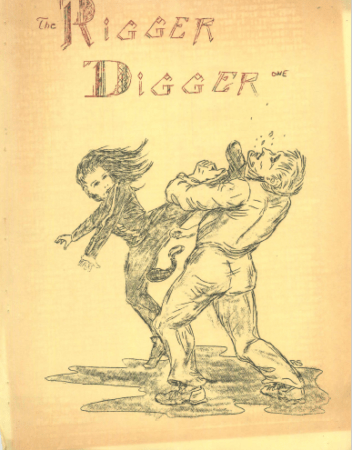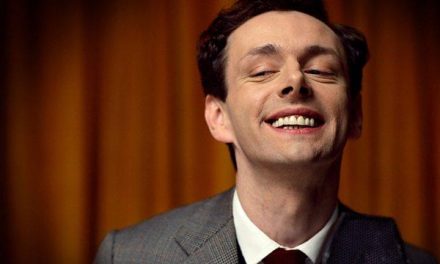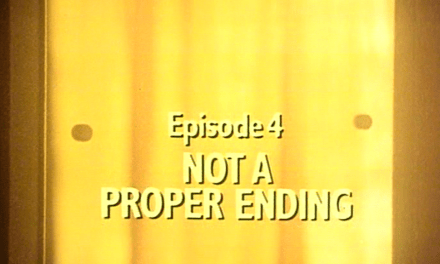“Now, the programme is made on film – since we can see what looks like a 35mm film camera in the chapel and the image has vertical tramline scratching of the sort you’d expect with film – but it’s in colour. That’s fine – there were television series being made in colour in the UK as early as Men, Women and Clothes in July 1956, and this is some time in the 1960s, so that’s okay. But at the end, the nuns are watching the programme on television in colour. So, let’s be charitable and say that this is meant to be on BBC2 which is operating a regular partial colour service at the start of July 1967. But this is a film series, and the BBC aren’t really doing film drama series after the Hornblower pilot (1963) and that second batch of The Third Man (1959-196Don’tGetMeStarted…) until the mid-1970s. And they didn’t buy in British filmed series around that time either. That Bedford van that we see is an ‘F’ reg, so it still suggests it’s after July 1967… so, maybe this is in the very dying weeks of 1969 and we’re in one of the ITV regions that’s operating a colour service from mid-November… Maybe I can read the date on the clapper-board when they’re shooting that scene in the chapel…”
I wish that I could claim to have found the above buried in the backwater of a small-minded television discussion forum, but, to my shame, it was a small voice screaming out from a miserable part my temporal lobes. Thankfully, the rest of my thought processes were shouting out in a far louder voice: “Oh, for hump’s sake! This is fun! Just sit back and enjoy it!” And, to my delight, it was the analytical element that was over-ruled in favour of sheer entertainment.
At the time, I was watching an episode of Operation QT (196X-196Y), and it was quite brilliant. The heavily made-up nun in her figure-hugging, slit-to-the-thigh habit and white PVC calf-length boots – answered the convent door to be confronted by an umbrella-carrying man in a trilby, pin-striped three-piece suit, tinted NHS glasses and his colleague, a striking woman with a stylish hair-do, light blue matching waistcoat and slacks, and murderously high heels.
HOOPER: Afternoon, Sister. Sorry to intrude. Agents Hooper and Lang, here. MI.5. Rather important we come inside. Chop, chop, there’s a good girl.
KATYA: Please, what is this about?
LANG: We know the significance of this convent. What it contains.
HOOPER: I’m afraid your location’s been discovered by enemies of the realm. They’re a rather uncivilised lot so time is of the essence.
LANG: They might be in the town already. Now think, Sister, have you been approached by anyone other than us?”
KATYA: No, we’ve had no other visitors.
(A SCREAM RINGS OUT FROM BEHIND KATYA. RUSHING INTO THE CHAPEL, HOOPER AND LANG FIND A GROUP OF NUNS, TIED UP AND GAGGED. KATYA DRAWS A GUN ON THEM)
KAYTA (RUSSIAN ACCENT): You will not succeed, Englishman! The meteor belongs to the Kremlin!
Now, you may have never heard of Operation QT… but then again, that’s only fair, because it’s probably never heard of you either. To quote Sister Peter, one of its loyal fans: “It’s quite, quite marvellous. It’s about MI.5 secret agents Rodney Hooper and Linda Lang, valiantly fighting international espionage and paranormal crime.”
Sister Peter is actually one of the semi-regular characters in Sister Boniface Mysteries (2022-), a rather wonderful period piece of detective hokum made by BBC Studios Drama Production which – instead of being given a lovely BBC One Sunday 7.15pm placing or even stripped weekdays at 2.15pm as it deserved – was hurled into the comparative oblivion of britbox (until it escaped onto Freeview via Drama a few months back – thank you Drama!). Set at some unspecified point in the 1960s (despite my ruminations above, another episode seems to act as a prelude to the filming of The Sound of Music which commenced in March 1964), it is a spin-off from the 1950s period sleuthing of Father Brown (2013-) and follows the criminal cases tackled by the Great Slaughter Constabulary of rural Warwickshire… assisted by Sister Boniface, a former boffin working at Bletchley Park and the holder of a PhD in forensic science who is only too happy – in her capacity as a scientific advisor – to rush from the wine-making cloisters of St Vincent’s convent aboard her Vespa-powered mobile crime lab to aid Detective Inspector Sam Gillespie, Detective Sergeant Felix Livingstone and WPC Peggy Button.
This particular episode, Lights, Camera, Murder!, is an absolute gem of a script by Dominique Moloney – creator of WPC 56 (2013-2015) and author of some cracking episodes of Shakespeare & Hathaway: Private Investigators (2018–) – and concerns the use of St Vincent’s for location work on an episode of Operation QT.
And – basically – as many of your will have already guessed, Operation QT is actually The Avengers (1961-1969), an off-beat crime-fighting caper series that helped to set Sixties styles, commencing the decade as dour monochrome videotaped tapes of espionage and exploitation, and mutating in stages into a camp, colourful celluloid caper.
The episode, with its loving homage to a show that I hold dear, is immense fun.
But the really captivating element for me was not so much the lovely homage, but Sister Peter, one of Sister Boniface’s fellow nuns who – in the 1960s – is a hard-core enthusiast of a mere television show, some years before such devotions generally became organised enough to coalesce into all manner of clubs and societies. And what’s even more wonderful is how Sister Peter rather confounds the present stereotype of the ‘TV fan’.
BRUNO MILTON: Didn’t think a nun would go in for that sort of thing.
SISTER PETER: Whyever not? I’ve not missed a single episode.
While the plot of the Operation QT episode revolves around a glowing meteor from outer space (assembled to the director’s chagrin from egg boxes) that emits evil forces that takes control of the Russian assassin nuns and spears their leader, Katya, with a flying crucifix… the narrative of Lights, Camera, Murder! concerns an apparent murder attempt made while filming in St Vincent’s chapel. A list of those with potential grudges against the series, its cast and crew is obtained from producer Dick Lansky by DS Livingstone. He then runs the suspects’ names past Sister Peter for further information while, nearby, stars Hugo Steele (alias Rodney Hooper) and Pamela Wishbone (aka Linda Lang) wait to resume filming:
SISTER PETER: Jasper Berridge. He played Professor Pringle in Series One and Two. He always gave mind-bogglingly complex scientific explanations to Hooper and Lang.
LIVINGSTONE: What about Derek Colt?
SISTER PETER: Don’t tell me, I know this one. Only appeared in one episode. The very first, in fact. He played agent Harry Stone, Hooper’s former partner in MI.5 before his tragic death in a motorbike crash.
HUGO STEELE: Oh, she’s… She’s very good.
PAMELA WISHBONE: Poor Derek. He was lucky to survive that stunt.
SISTER PETER: Oh! You mean the fireball was real?
PAMELA WISHBONE: Dick never wastes a good take.
LIVINGSTONE: Marigold Fritz?
SISTER PETER: Four episodes, Series Three. She played Pippa Davinshire, one-time love interest for Agent Hooper. Exposed as a double agent by Agent Lang. At first it seemed Agent Lang was just jealous, but she was proven right when…
And this is the moment that I adored, because here we have Sister Peter speaking about Operation QT in the same way that I’d speak to colleagues and friends about The Avengers. Of course, I’m also amused by the rather anachronistic feel of her words and terminology… almost as if back in 196whatever she had been able to view the episodes repeatedly in a boxed set binge, or had poured over the episode credits on some dedicated fan wiki site. “Series One and Two”… as we’ve observed before, outside of television itself, wasn’t how viewers tended to think or speak… And it’s always nice to see a story arc – even for four episodes – which were very rare in film series of the time (mainly because of the need to hit ‘reset’ after each closing credits).
Back in the 1960s, television was instant and ephemeral with effectively no home recording devices; the claim to have “never missed an episode” is one that might have been aided if St Vincent’s was in a part of Worcestershire that maybe also managed to receive a weak signal from the TWW/HTV area in addition to ATV/ABC, giving the additional scheduling quirks of a series that maybe aired on Tuesdays in one area going out on Fridays in another… At least Operation QT was on film, so there would have been plenty of chances for off-peak reruns in late-night slots between repeats of Danger Man (1964-1966).
But, yes, Sister Peter could well have amassed all this information. After all, singer-turned-decorator-turned-writer Dave Rogers was making notes on The Avengers back in the 1960s and used them as the starting point for his landmark work The Avengers published by Michael Joseph and ITV Books on Monday 25 April 1983. I took the morning off school to go into town to purchase this volume – a massively exciting and important tome that spearheaded the first major wave of UK books to study and chronicle archive television. [1]
And, you know what, Sister Peter could have written to the production company for press books and promotional material with storylines and credits. Or, she could have kept a scrapbook with all the programme billings from TV Times, TV World and TVTimes (yes, I know I’ve said it once in this list, but this time I’m saying it without a gap) lovingly pasted into it, annotated with her own synopses written after transmission. And I’d like to think that she did just that…
… or maybe even back then she’d been able to hook up with other fans of Hooper and Lang in the pre-internet days. After all, 4 October 1967 had seen the publication of Issue One of The Rigger Digger, a 32-page fanzine dedicated to The Avengers (or more specifically Diana Rigg who played Mrs Emma Peel alongside Patrick Macnee who portrayed the bowler-wearing John Steed) assembled by Richard Schultz of Detroit, Michigan. His text bubbles over with enthusiasm for the show from his first glimpse when it was networked by ABC in March 1966, he recounts how he has seen one of the earlier episodes with Honor Blackman alongside Mr Macnee and how he heard British members of the Fantasy Amateur Press Association discussing the formative era, he expounds his fears that the network may curtail the show, and he recalls discussing the series at the New York Science Fiction Convention. There was news from press cuttings about the stars, snippets on books, comics and toys spawned by the show, Cleveland Amory’s TV Guide review of a recent episode, and a list of photos that he had for sale. [2]
I mean, shot on colour film in the late 1960s!? I’m sure that Operation QT would have been aimed at the transatlantic market by then, and – hopefully – aired on one of the US networks, or at the very least in syndication. I do hope that Sister Peter had fun with her Hooper and Lang fandom – I’m not sure that St Vincent’s would have run to cosplay (beyond the episode with the meteor and assassin nuns), but possibly a bit of fan fiction that could have been sent to fanzines along with the odd LoC [3].
So, if Dominique Moloney ever wonders if her homage to The Avengers was appreciated then – YES! – it most certainly was. And if she’d ever like to actually to make a series of Operation QT itself, then my wife and I would be most delighted to watch them… and maybe even seek out Sister Peter if she’s still around to swap notes with and understand how she reacted to the shows sixty years ago. Sister Peter seems kinda fun… and I’m sure she never forgot the day when she was able to help out Hooper and Lang with her single line: “They went that-a-way!” Yes, I’d love to hear her tell me all about that…
Andrew Pixley is a retired data developer. For the last 30 years he’s written about almost anything to do with television if people will pay him – and occasionally when they won’t. Recently on his hard drive, he discovered a whole stack of data about ITV transmissions of The Avengers that he’d put together for a data project a few years ago and forgotten about. It was doing no good there and it had no commercial potential, so he dumped the whole lot here to make it available for anyone who might find it of use or interest. But – be warned: its content could seriously devalue shares in Horlicks.
Footnotes
[1] Dave went on to publish an Avengers fanzine of his own – On Target and Stay Tuned – from 1983 to 1999. A selection of articles from these have been collected together by Mark Witherspoon into a volume entitled Stay Tuned to The Avengers. By the time you read this, there may even be a second volume.
[2] And if you want to read it and the issues of En Garde that followed, then fill your boots.
[3] You can Google that yourselves. Where on earth were you in the 1990s?


